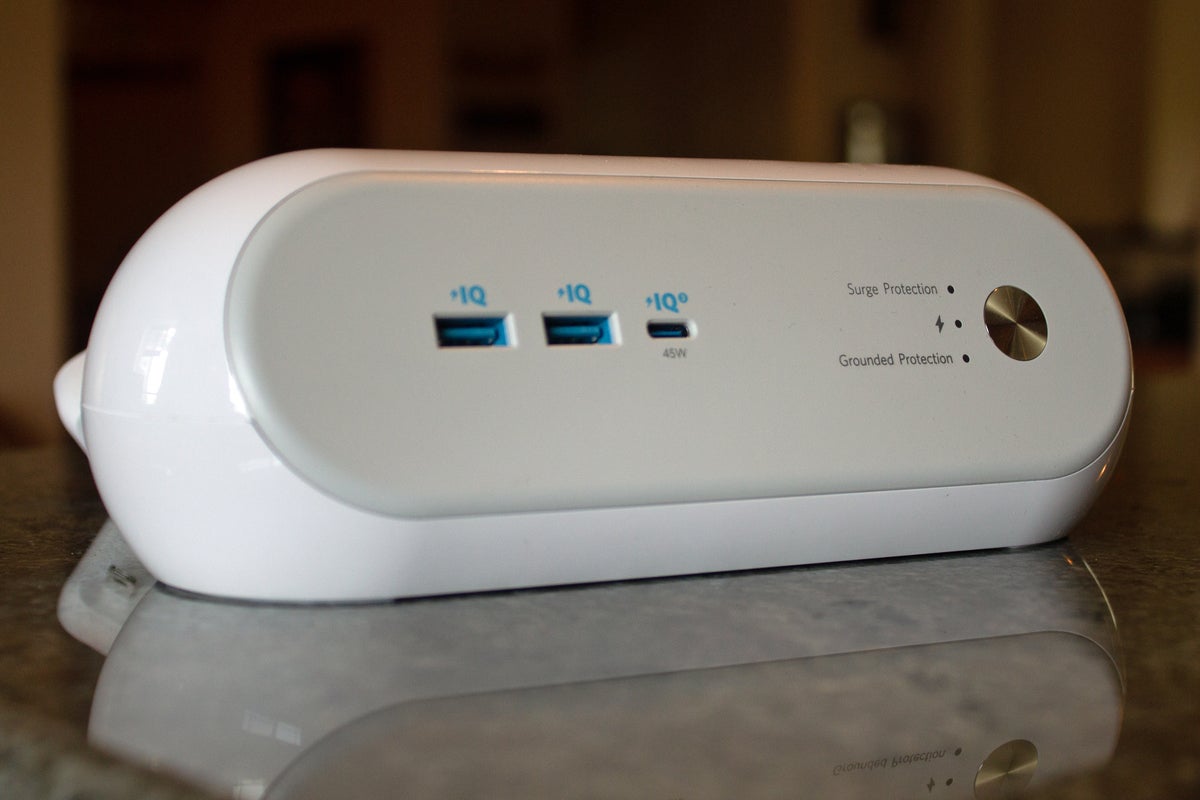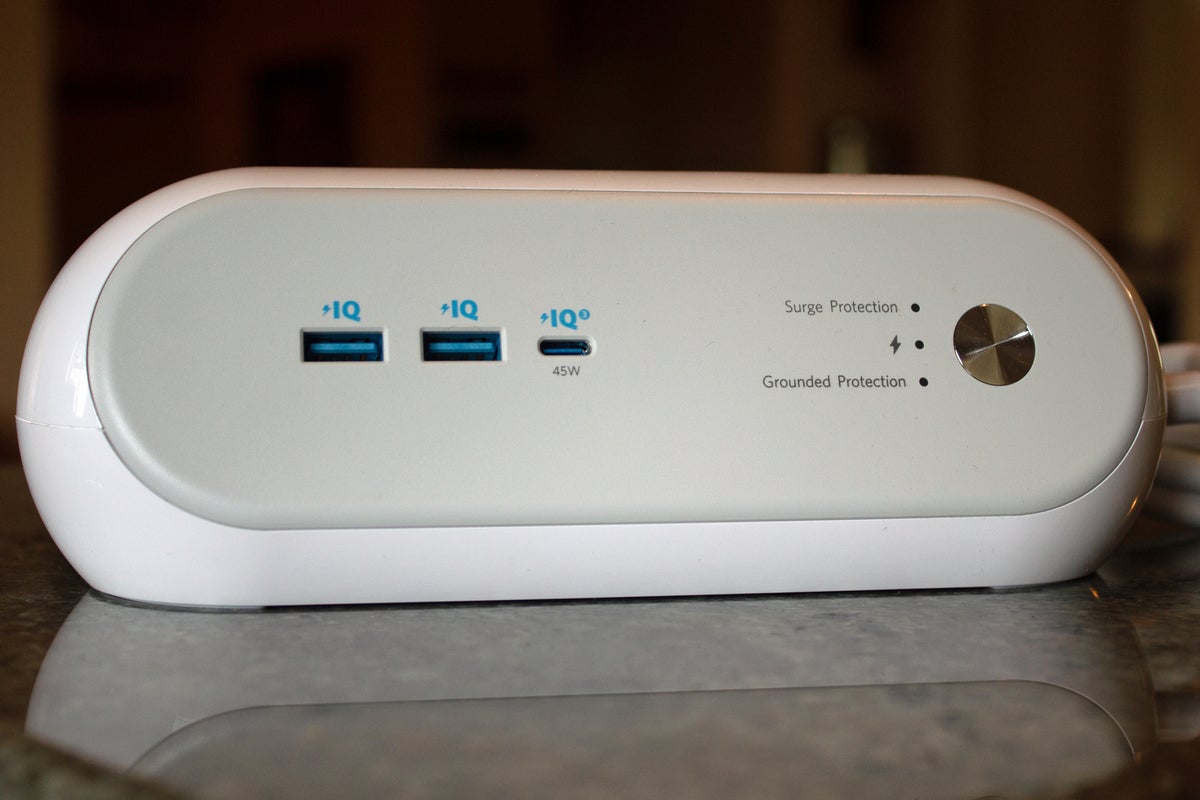This surge protector has just three outlets, two USB-A ports, and one USB-C port, but they come in an attractively compact package.
Michael Brown / IDG
Today’s Best Tech Deals
Picked by TechHive’s Editors
Top Deals On Great Products
Picked by Techconnect’s Editors
Anker PowerExtend USB-C 3 Capsule
Too many surge protectors look like they’re designed to be hidden behind your desk, and that’s all well and good, so long as you don’t intend to swap plugs too often. But if you do need easy access to your surge protector, you’ll probably want to pick one that isn’t flat-out ugly.
The Anker PowerExtend USB-C 3 Capsule can’t accommodate a lot of devices, but it’s attractive enough to leave out in plain sight, and its AC outlet orientation keeps wall warts out of sight while leaving its three USB charging ports easily accessible. These outlets are well spaced and arranged at angles that allow for easy cord management. I had no problem plugging three oversized DC power supplies into them.
This review is part of TechHive’s coverage of the best surge protectors, where you’ll find reviews of competing products, plus a buyer’s guide to the features you should consider when shopping for this type of product.
 Michael Brown / IDG
Michael Brown / IDGTwo fast-charging USB-A and one USB-C ports are the highlights of Anker’s PowerExtend USB-C 3 Capsule surge protector.
You only get two USB-A and one USB-C charging ports, but these have a combined power budget of 60 watts. The two USB-A ports are allocated 15 watts (5V-3A, 2.4A maximum per port), while the single USB-C port can accommodate laptops in addition to smartphones and tablets, delivering 5V-2.4A (12 watts), 9V-3A (27 watts), 15V-3A (45 watts), or 20V-2.25A (45 watts), depending on the client. The surge protector has a 5-foot 16 AWG power cord terminating with a low-profile plug oriented at a 45-degree angle that won’t block an adjacent outlet.
The USB-C charging port is compatible with Qualcomm’s Quick Charge, USB Power Delivery, Apple Fast Charging, and Samsung Fast Charging technologies—not bad for a device that measures just 8 x 2.75 x 3 inches (WxDxH). The price tag is a bit less exciting: $69.99 at Amazon (although Anker was offering a $20 discount coupon at press time).
This is the type of surge protector that continues to provide power after its MOVs have burned out, so you’ll want to verify that the blue LED labeled “surge protection” remains illuminated, assuring you that your devices are protected. On the topic of MOVs, the PowerExtend has a very high clamping ceiling: 775 volts at 50 amps. It also has a low joules rating (300), and there’s no internal circuit breaker with a reset button. If you live in an area with unstable power or frequent thunderstorms, you might want something more robust.
 Michael Brown / IDG
Michael Brown / IDGI had no problem plugging three large power adapters into the back of Anker’s PowerExtend USB-C 3 Capsule.
A second blue LED informs you when power is flowing, and a third tells you the outlet strip is connected to a properly grounded outlet. (If the third LED doesn’t light up when you plug the surge protector in, consult a electrician, because the outlet you’re using is not properly grounded.) A round silver button to the right of the LEDs turns the outlet strip on and off. I have a bedside lamp with a thumbwheel switch on its power cord that’s not convenient to reach, so I was hoping the PowerExtend’s button would shut off only its AC outlets. Alas, that’s not the case, as the button also turns the USB charging ports on and off.
The Anker PowerExtend USB-C 3 Capsule won’t accommodate a lot of hardware, and it’s not the best choice for those living in areas that experience frequent lightning storms (unless you have a whole-home surge protector installed in your circuit-breaker panel). That said, its compact size, attractive industrial design, and fast-charging features make it an attractive option if you don’t need more than one USB-C charging port.
Note: When you purchase something after clicking links in our articles, we may earn a small commission. Read our affiliate link policy for more details.
Anker PowerExtend USB-C 3 Capsule
A 45-watt USB-C charging port is this pricey surge protector’s best feature.
Pros
- 60-watt power budget for its three USB charging ports
- USB-C charging port allocated 45 watts
- Compact size and sensible outlet arrangement make for easy cord management
- Attractive design
Cons
- No internal overload protection
- Only one USB-C charging port
- Power switch turns off USB charging ports as well as AC outlets
Michael covers the smart-home, home-entertainment, and home-networking beats, working in the smart home he built in 2007.


